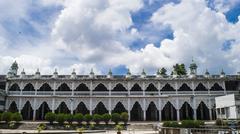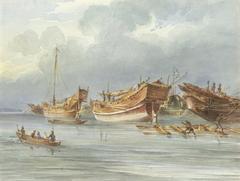Wali Khan Mosque: Visiting Hours, Tickets, and Historical Significance in Chittagong
Date: 04/07/2025
Introduction
Located at the vibrant heart of Chittagong’s historic Chawk Bazar, Wali Khan Mosque stands as an enduring testament to Mughal architecture and Islamic heritage in Bangladesh. Built between 1713 and 1716 CE by Wali Beg Khan, the Mughal Faujdar (military governor) of Chittagong, this mosque represents centuries of religious devotion, cultural exchange, and urban development. Its six domes, distinctive octagonal towers, and grand eastern façade offer visitors a glimpse into the artistic and architectural sophistication of the Mughal era. Today, the mosque remains a hub for worship and community life, welcoming a diverse range of visitors with free admission and accessible visiting hours (Banglapedia; Bproperty; HollyMelody).
This comprehensive guide provides an in-depth look at the mosque’s origins, architectural features, socio-religious significance, current preservation efforts, and practical information for visitors.
Table of Contents
- Historical Origins and Patronage
- Architectural Highlights
- Chittagong under Mughal Rule
- Socio-Religious Importance
- Visiting Wali Khan Mosque: Practical Information
- Nearby Attractions
- Preservation and Cultural Legacy
- Challenges and Conservation Efforts
- Frequently Asked Questions (FAQs)
- Conclusion
Historical Origins and Patronage
The Wali Khan Mosque owes its existence to Wali Beg Khan, who served as the Mughal Faujdar of Chittagong in the early 18th century. His vision extended beyond religious devotion; by founding Chawk Bazar and endowing the mosque with 120 dronas of land across Kadalpur, Nizampur, and Sandwip, he established a sustainable model for mosque maintenance through waqf (charitable endowment). This reflects the Mughal tradition of integrating religious, social, and urban development, positioning the mosque as a central institution in Chittagong’s evolving civic landscape (Banglapedia).
Architectural Highlights
Wali Khan Mosque features a rectangular plan with a double-aisled prayer hall, a hallmark of Mughal design adapted to the Bengal region. The building is crowned with six domes arranged in two rows—an uncommon feature in Bengal, where three or five domes are more typical. Each corner is marked by an engaged octagonal tower capped with a domed finial, adding vertical emphasis to the structure.
The eastern façade presents three grand arched entrances, with the central portal framed by a rectangular fronton. Inside, the prayer hall contains three mihrabs on the qibla wall, with the central mihrab projecting outward as the spiritual focal point. Although some original plasterwork and decorative motifs have faded due to renovations, the mosque’s core architectural features vividly illustrate Mughal artistry (Bproperty).
Chittagong under Mughal Rule
Chittagong’s strategic location on the Bay of Bengal made it a sought-after port, changing hands among various rulers before the Mughal consolidation in the late 17th century. The Mughal military campaigns integrated Chittagong into the Bengal Subah (province), fostering urban growth and architectural developments such as the Wali Khan Mosque and the founding of Chawk Bazar. These projects not only asserted Mughal authority but also facilitated the spread of Islamic culture in southeastern Bengal (HollyMelody).
Socio-Religious Importance
Historically, Wali Khan Mosque was more than a place of worship. It functioned as a center for community gatherings, education, and legal affairs. Its proximity to Wali Beg Khan’s residence and administrative offices, as well as the nearby Kamaldaha tank (commissioned for ablutions and daily needs), underlines its civic significance. The mosque’s endowment funded religious officials and caretakers, ensuring its sustainability and embedding it within the social fabric of Chittagong (Banglapedia; Bproperty).
Visiting Wali Khan Mosque: Practical Information
- Visiting Hours: Generally open daily from 6:00 AM to 8:00 PM. During religious festivals, hours may vary; check locally for any changes.
- Entry Fee: Admission is free for all visitors.
- Accessibility: The main entrance is wheelchair accessible, though uneven flooring is present due to the mosque’s historic structure. The surrounding area is densely built-up; narrow streets may require assistance for those with mobility challenges.
- Photography: Photography is permitted, but visitors should be respectful, especially during prayer times.
- Guided Tours: No official guided tours are currently provided onsite, but local guides and tour operators often include the mosque in historical tours. Inquire with local tourism offices for personalized experiences (explorecity.life).
Nearby Attractions
Enhance your visit by exploring other notable historical and cultural sites near the mosque:
- Chandanpura Jame Masjid: A striking example of Mughal-era mosque architecture.
- Anderkilla Shahi Jame Mosque: Renowned for its historical significance and unique design.
- Chawk Bazar: The historic commercial hub, also founded by Wali Khan.
- Kamaldaha Tank: A large historic water tank nearby, significant for local daily life.
- Chittagong Ethnological Museum and Patenga Beach: For a broader cultural and leisure experience.
Preservation and Cultural Legacy
Wali Khan Mosque is recognized as a protected heritage site, but its conservation faces challenges. Multiple renovations and urban encroachment have altered some original features, while environmental factors like monsoon rains and pollution contribute to wear. Despite these pressures, the mosque remains an active religious site and a symbol of Chittagong’s Islamic heritage. Preservation efforts by the Department of Archaeology and local NGOs, combined with community stewardship and donations, underscore its enduring value (Bproperty; Banglapedia).
Challenges and Conservation Efforts
Structural and Environmental Risks
The mosque’s original brickwork and domes have suffered from cracks, efflorescence, and plaster flaking due to Chittagong’s humid climate and heavy monsoons. Urban encroachment has reduced its original grounds, and air pollution accelerates surface degradation. Drainage improvements have been made, but limited funding impedes comprehensive restoration (explorecity.life).
Conservation Initiatives
The Department of Archaeology supervises maintenance, while local NGOs and heritage groups organize cleaning drives and minor repairs. Community involvement, through donations and volunteer labor, is vital for the mosque’s ongoing upkeep. However, challenges remain, such as the use of inappropriate modern materials during repairs and the need for technical training in conservation methods.
Frequently Asked Questions (FAQs)
Q: What are the Wali Khan Mosque visiting hours?
A: The mosque is open daily from 6:00 AM to 8:00 PM, though hours may vary during religious events.
Q: Is there an entrance fee?
A: No, entry is free for all visitors.
Q: Are guided tours available?
A: No official guided tours are regularly offered, but local guides often include the mosque in their historical tours.
Q: Is the mosque accessible for people with disabilities?
A: The main entrance is wheelchair accessible, but the area’s narrow streets and some uneven floors may pose challenges.
Q: Can visitors take photographs inside the mosque?
A: Yes, but please be respectful during prayer times.
Q: What other attractions are nearby?
A: Chandanpura Jame Masjid, Anderkilla Shahi Jame Mosque, Chawk Bazar, Kamaldaha Tank, Chittagong Ethnological Museum, and Patenga Beach.
Q: What should visitors wear?
A: Modest dress is required; shoes must be removed before entering the prayer hall.
Conclusion
The Wali Khan Mosque is more than a historical monument; it is a living symbol of Chittagong’s Mughal legacy, Islamic architectural brilliance, and community spirit. Despite the challenges of urbanization, environmental wear, and conservation needs, the mosque continues to serve as a dynamic center for worship and a cherished cultural landmark. Free entry, generous visiting hours, and a welcoming atmosphere make it accessible to all. Enhance your experience by exploring nearby heritage sites and supporting ongoing preservation.
For the latest visitor information, guided tour options, and travel tips, use the Audiala app and consult local resources. By engaging respectfully with the mosque’s spiritual ambiance and supporting preservation efforts, visitors help safeguard this remarkable monument for future generations (Banglapedia; Bproperty; explorecity.life).
References and Further Reading
- Wali Khan Mosque: Visiting Hours, Tickets, and History of Chittagong’s Mughal Landmark, Banglapedia
- Historical Landmarks in Chattogram, Bproperty
- Chittagong: Interesting Facts, Famous Things & History, HollyMelody
- Wali Khan Mosque: Visiting Hours, Tickets, and Preservation Challenges, explorecity.life
- A Study of The Mughul Architectural Heritage in Chittagong City, Scribd
- Top 10 Beautiful Mosques in Bangladesh, Hujaifa
- Most Visited Mosques in Bangladesh: Sacred Spaces and Cultural Icons, ZoomBangla

